Contribution to the Topological Optimization of Reactive Flows
Abstract
1. Introduction
2. Topology Optimization of Flow
2.1. Geometry Description
2.2. Optimum Search Algorithm
2.2.1. Non-Gradient Methods
2.2.2. Gradient Methods
2.2.3. Gradient Calculation
3. Case Study
3.1. Algorithm Validation with Bend Pipe Case and Duct Case
3.2. Optimization of Second-Order Chemical Reactions for 2D Duct Case
4. Discussion
5. Summary and Outlook
Author Contributions
Funding
Data Availability Statement
Conflicts of Interest
List of Symbols
| Design variable | |
| Design vector | |
| Cost function/constraint | |
| Constraint | |
| Volume of the study domain | |
| Boundary of the study domain | |
| Nabal/gradient operator | |
| Identity matrix | |
| Density | |
| Time | |
| Velocity vector | |
| Pressure, or descent step | |
| Chemical specie | |
| Mass fraction of the chemical species | |
| Viscous stress tensor | |
| Inverse permeability field | |
| Penalization parameter | |
| Descent direction | |
| Lagrangian | |
| , , | Vector of Lagrange multipliers |
| Lagrange multiplier | |
| Kinematic viscosity | |
| Diffusion coefficient | |
| Thermal diffusivity | |
| Constant reaction rate | |
| Enthalpy of reaction | |
| Heat capacity |
Appendix A
Appendix A.1. Gradients of Cost Function and Constraints
Appendix A.2. Adjoint Systems
References
- Junejo, A.; Al-Abdeli, Y.M.; Porteiro, J. Role of Air Staging in a Batch-Type Fixed Bed Biomass Combustor under Constant Primary Air. J. Therm. Sci. 2024, 33, 284–299. [Google Scholar] [CrossRef]
- Tu, Y.; Zhang, H.; Guiberti, T.F.; Avila Jimenez, C.D.; Liu, H.; Roberts, W.L. Experimental and numerical study of combustion and emission characteristics of NH3/CH4/air premixed swirling flames with air-staging in a model combustor. Appl. Energy 2024, 367, 123370. [Google Scholar] [CrossRef]
- Srinivasarao, M.; Kumar, S.; Jik Lee, B.; Giri, B.R.; Shrestha, K.P.; Mahendra Reddy, V. Experimental and numerical analysis on influence of air staging in a tangential flow burner for pure ammonia combustion. Appl. Therm. Eng. 2025, 266, 125580. [Google Scholar] [CrossRef]
- Borrvall, T.; Petersson, J. Topology optimization of fluids in Stokes flow. Int. J. Numer. Methods Fluids 2003, 41, 77–107. [Google Scholar] [CrossRef]
- Alexandersen, J.; Andreasen, C.S. A Review of Topology Optimisation for Fluid-Based Problems. Fluids 2020, 5, 29. [Google Scholar] [CrossRef]
- Li, H.; Wang, C.; Zhang, X.; Li, J.; Shen, J.; Zhou, S. A Mini Review on Fluid Topology Optimization. Materials 2023, 16, 6073. [Google Scholar] [CrossRef]
- Abdel Nour, W.; Jabbour, J.; Serret, D.; Meliga, P.; Hachem, E. A Stabilized Finite Element Framework for Anisotropic Adaptive Topology Optimization of Incompressible Fluid Flows. Fluids 2023, 8, 232. [Google Scholar] [CrossRef]
- Liu, J.; Li, R.; Chen, Y.; Zheng, J.; Wang, K. Topology Optimization Method of a Cavity Receiver and Built-In Net-Based Flow Channels for a Solar Parabolic Dish Collector. Entropy 2023, 25, 398. [Google Scholar] [CrossRef]
- Zhao, N.; Zhang, J.; Han, H.; Miao, Y.; Deng, Y. Topology Optimization of Hydrodynamic Body Shape for Drag Reduction in Low Reynolds Number Based on Variable Density Method. Appl. Sci. 2023, 13, 5461. [Google Scholar] [CrossRef]
- Okkels, F.; Bruus, H. Scaling behavior of optimally structured catalytic microfluidic reactors. Phys. Rev. E 2007, 75, 16301. [Google Scholar] [CrossRef]
- Okkels, F.; Bruus, H. Design of Micro-Fluidic Bio-Reactors Using Topology Optimization. J. Comput. Theor. Nanosci. 2007, 4, 814–816. [Google Scholar] [CrossRef][Green Version]
- Schäpper, D.; Lencastre Fernandes, R.; Lantz, A.E.; Okkels, F.; Bruus, H.; Gernaey, K.V. Topology optimized microbioreactors. Biotechnol. Bioeng. 2011, 108, 786–796. [Google Scholar] [CrossRef]
- Yaji, K.; Yamasaki, S.; Tsushima, S.; Suzuki, T.; Fujita, K. Topology optimization for the design of flow fields in a redox flow battery. Struct. Multidiscip. Optim. 2018, 57, 535–546. [Google Scholar] [CrossRef]
- Behrou, R.; Pizzolato, A.; Forner-Cuenca, A. Topology optimization as a powerful tool to design advanced PEMFCs flow fields. Int. J. Heat Mass Transf. 2019, 135, 72–92. [Google Scholar] [CrossRef]
- Dugast, F.; Favennec, Y.; Josset, C. Reactive fluid flow topology optimization with the multi-relaxation time lattice Boltzmann method and a level-set function. J. Comput. Phys. 2020, 409, 109252. [Google Scholar] [CrossRef]
- Liu, X.; Chen, L.; Tao, W.-Q. Effects of physicochemical parameters on the optimized topology of catalyst in micro reactors. Front. Heat Mass Transf. 2020, 14, 1–9. [Google Scholar] [CrossRef]
- Jia, S.; Cao, X.; Yuan, X.; Yu, K.-T. Multi-objective topology optimization for the solar thermal decomposition of methane reactor enhancement. Chem. Eng. Sci. 2021, 231, 116265. [Google Scholar] [CrossRef]
- Bhattacharjee, D.; Atta, A. Topology optimization of a packed bed microreactor involving pressure driven non-Newtonian fluids. React. Chem. Eng. 2022, 7, 609–618. [Google Scholar] [CrossRef]
- Wang, J.; Wang, Y.; Ma, L.; Liu, X. Multi-objective topology optimization and flow characteristics study of the microfluidic reactor. React. Kinet. Mech. Catal. 2022, 135, 2475–2501. [Google Scholar] [CrossRef]
- Guo, C.; Chen, L.; Tao, W. Topology optimization of microreactors for hydrogen production by ammonia catalytic decomposition. Int. J. Hydrogen Energy 2024, 96, 923–937. [Google Scholar] [CrossRef]
- Sigmund, O.; Petersson, J. Numerical instabilities in topology optimization: A survey on procedures dealing with checkerboards, mesh-dependencies and local minima. Struct. Optim. 1998, 16, 68–75. [Google Scholar] [CrossRef]
- Zuo, K.-T.; Chen, L.-P.; Zhang, Y.-Q.; Yang, J. Study of key algorithms in topology optimization. Int. J. Adv. Manuf. Technol. 2007, 32, 787–796. [Google Scholar] [CrossRef]
- Bendsøe, M.P. Optimal shape design as a material distribution problem. Struct. Optim. 1989, 1, 193–202. [Google Scholar] [CrossRef]
- Zhou, M.; Rozvany, G.I.N. The COC algorithm, Part II: Topological, geometrical and generalized shape optimization. Comput. Methods Appl. Mech. Eng. 1991, 89, 309–336. [Google Scholar] [CrossRef]
- Mlejnek, H.P. Some aspects of the genesis of structures. Struct. Optim. 1992, 5, 64–69. [Google Scholar] [CrossRef]
- Sigmund, O.; Maute, K. Topology optimization approaches: A comparative review. Struct. Multidiscip. Optim. 2013, 48, 1031–1055. [Google Scholar] [CrossRef]
- Eberhart, R.; Kennedy, J. A new optimizer using particle swarm theory. In Proceedings of the Sixth International Symposium on Micro Machine and Human Science (MHS’95), Nagoya, Japan, 4–6 October 1995; IEEE: New York, NY, USA, 1995; pp. 39–43. [Google Scholar]
- Wu, X.; Han, J.; Wang, D.; Gao, P.; Cui, Q.; Chen, L.; Liang, Y.; Huang, H.; Lee, H.P.; Miao, C.; et al. Incorporating Surprisingly Popular Algorithm and Euclidean distance-based adaptive topology into PSO. Swarm Evol. Comput. 2023, 76, 101222. [Google Scholar] [CrossRef]
- Luh, G.-C.; Lin, C.-Y.; Lin, Y.-S. A binary particle swarm optimization for continuum structural topology optimization. Appl. Soft Comput. 2011, 11, 2833–2844. [Google Scholar] [CrossRef]
- Najafabadi, H.R.; Goto, T.; Falheiro, M.; Martins, T.C.; Barari, A.; Tsuzuki, M.S.G. Post-Processing of non gradient-based Topology Optimization with Simulated Annealing. IFAC-PapersOnLine 2021, 54, 755–760. [Google Scholar] [CrossRef]
- Kirkpatrick, S.; Gelatt, C.D.; Vecchi, M.P. Optimization by simulated annealing. Science 1983, 220, 671–680. [Google Scholar] [CrossRef]
- Černý, V. Thermodynamical approach to the traveling salesman problem: An efficient simulation algorithm. J. Optim. Theory Appl. 1985, 45, 41–51. [Google Scholar] [CrossRef]
- Kaveh, A.; Hassani, B.; Shojaee, S.; Tavakkoli, S.M. Structural topology optimization using ant colony methodology. Eng. Struct. 2008, 30, 2559–2565. [Google Scholar] [CrossRef]
- Yoo, K.-S.; Han, S.-Y. A modified ant colony optimization algorithm for dynamic topology optimization. Comput. Struct. 2013, 123, 68–78. [Google Scholar] [CrossRef]
- Lee, K.S.; Geem, Z.W. A new structural optimization method based on the harmony search algorithm. Comput. Struct. 2004, 82, 781–798. [Google Scholar] [CrossRef]
- Qin, F.; Zain, A.M.; Zhou, K.-Q. Harmony search algorithm and related variants: A systematic review. Swarm Evol. Comput. 2022, 74, 101126. [Google Scholar] [CrossRef]
- Storn, R.; Price, K. Differential Evolution—A simple and efficient adaptive scheme for global optimization over continuous spaces. J. Glob. Optim. 1995, 11, 341–359. [Google Scholar] [CrossRef]
- Storn, R. Differential Evolution—A Simple and Efficient Heuristic for Global Optimization over Continuous Spaces. Differ. Evol. 1997, 11, 341–359. [Google Scholar] [CrossRef]
- Wu, C.-Y.; Tseng, K.-Y. Topology optimization of structures using modified binary differential evolution. Struct. Multidiscip. Optim. 2010, 42, 939–953. [Google Scholar] [CrossRef]
- Luh, G.-C.; Chueh, C.-H. Multi-modal topological optimization of structure using immune algorithm. Comput. Methods Appl. Mech. Eng. 2004, 193, 4035–4055. [Google Scholar] [CrossRef]
- Xie, Y.M.; Steven, G.P. A simple evolutionary procedure for structural optimization. Comput. Struct. 1993, 49, 885–896. [Google Scholar] [CrossRef]
- Young, V.; Querin, O.M.; Steven, G.P.; Xie, Y.M. 3D and multiple load case bi-directional evolutionary structural optimization (BESO). Struct. Optim. 1999, 18, 183–192. [Google Scholar] [CrossRef]
- Jakiela, M.J.; Chapman, C.; Duda, J.; Adewuya, A.; Saitou, K. Continuum structural topology design with genetic algorithms. Comput. Methods Appl. Mech. Eng. 2000, 186, 339–356. [Google Scholar] [CrossRef]
- Chapman, C.D. Structural Topology Optimization via the Genetic Algorithm. Master’s Thesis, Massachusetts Institute of Technology, Department of Mechanical Engineering, Cambridge, MA, USA, 1994. [Google Scholar]
- Holland, J. Adaptation in Natural and Artificial System; University of Michigan Press: Ann Arbor, MI, USA, 1975. [Google Scholar]
- Kicinger, R.; Arciszewski, T.; Jong, K.D. Evolutionary computation and structural design: A survey of the state-of-the-art. Comput. Struct. 2005, 83, 1943–1978. [Google Scholar] [CrossRef]
- Sigmund, O. On the usefulness of non-gradient approaches in topology optimization. Struct. Multidiscip. Optim. 2011, 43, 589–596. [Google Scholar] [CrossRef]
- Gilbert, J.C. Optimisation Différentiable; AF1252 V1; Techniques de l’ingénieur: Saint-Denis, France, 2008. [Google Scholar] [CrossRef]
- Cauchy, M.A. Méthode générale pour la résolution des systèmes d’équations simultanées. Comp. Rend. Sci. Paris 1847, 25, 536–538. [Google Scholar]
- Fleury, C. CONLIN: An efficient dual optimizer based on convex approximation concepts. Struct. Optim. 1989, 1, 81–89. [Google Scholar] [CrossRef]
- Svanberg, K. The method of moving asymptotes—A new method for structural optimization. Int. J. Numer. Methods Eng. 1987, 24, 359–373. [Google Scholar] [CrossRef]
- Svanberg, K. A Class of Globally Convergent Optimization Methods Based on Conservative Convex Separable Approximations. SIAM J. Optim. 2002, 12, 555–573. [Google Scholar] [CrossRef]
- Giles, M.B.; Pierce, N.B. An introduction to the adjoint approach to design. Flow Turbul. Combust. 2000, 65, 393–415. [Google Scholar] [CrossRef]
- Bradley, A.M. PDE-Constrained Optimization and the Adjoint Method. 2010. Available online: https://cs.stanford.edu/~ambrad/adjoint_tutorial.pdf (accessed on 10 August 2025).
- Yoon, G.H. Topology optimization method with finite elements based on the k- ε turbulence model. Comput. Methods Appl. Mech. Eng. 2020, 361, 112784. [Google Scholar] [CrossRef]
- Yoon, G.H. Topology optimization for turbulent flow with Spalart–Allmaras model. Comput. Methods Appl. Mech. Eng. 2016, 303, 288–311. [Google Scholar] [CrossRef]
- Na, J.; Li, H.; Yan, P.; Li, X.; Gao, X. An open-source topology optimization modeling framework for the design of passive micromixer structure. Chem. Eng. Sci. 2022, 259, 117820. [Google Scholar] [CrossRef]
- Yoshimura, M.; Shimoyama, K.; Misaka, T.; Obayashi, S. Topology optimization of fluid problems using genetic algorithm assisted by the Kriging model: Topology optimization using a kriging-based genetic algorithm. Int. J. Numer. Methods Eng. 2017, 109, 514–532. [Google Scholar] [CrossRef]
- Duan, X.; Li, F.; Qin, X. Topology optimization of incompressible Navier–Stokes problem by level set based adaptive mesh method. Comput. Math. Appl. 2016, 72, 1131–1141. [Google Scholar] [CrossRef]

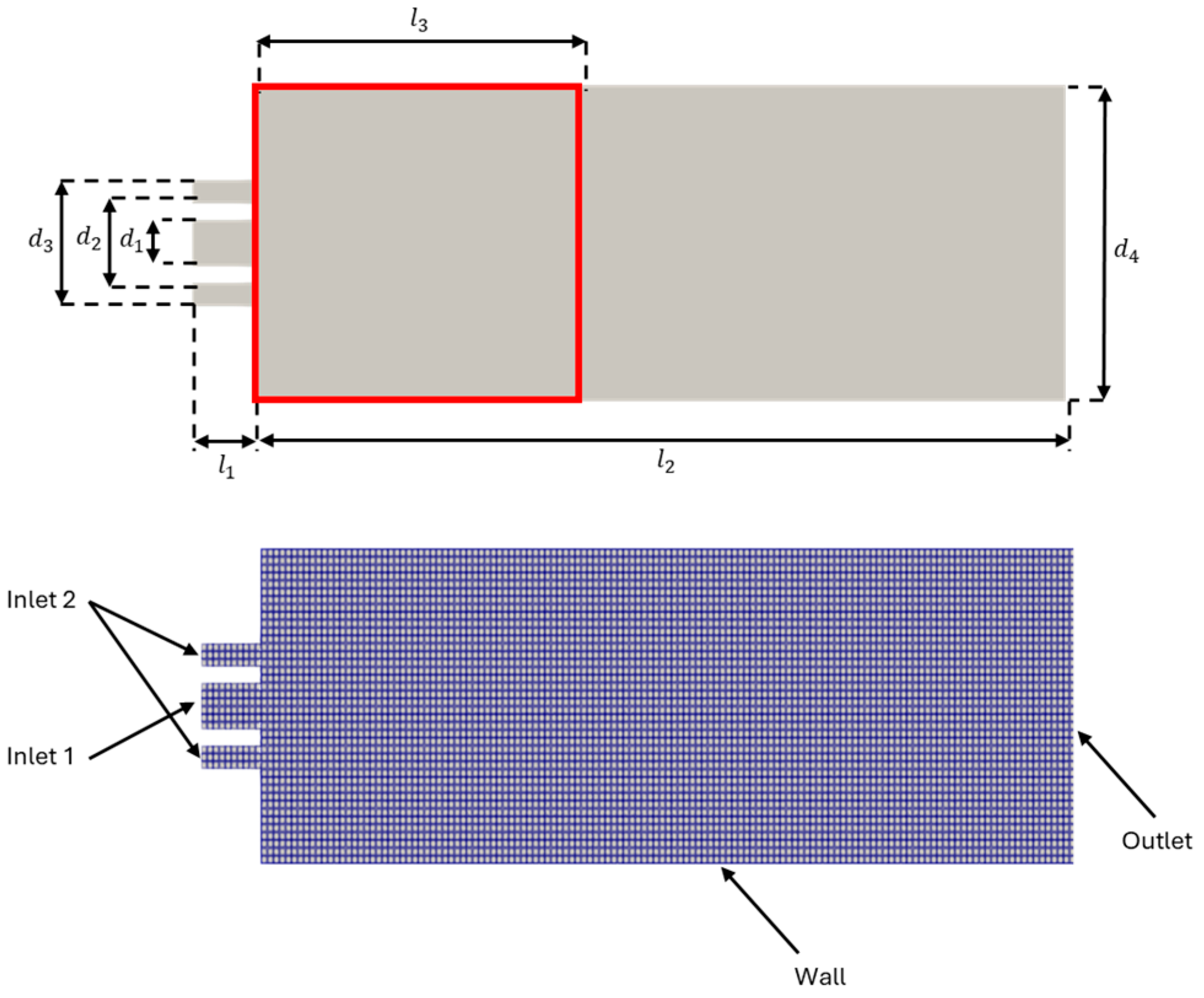
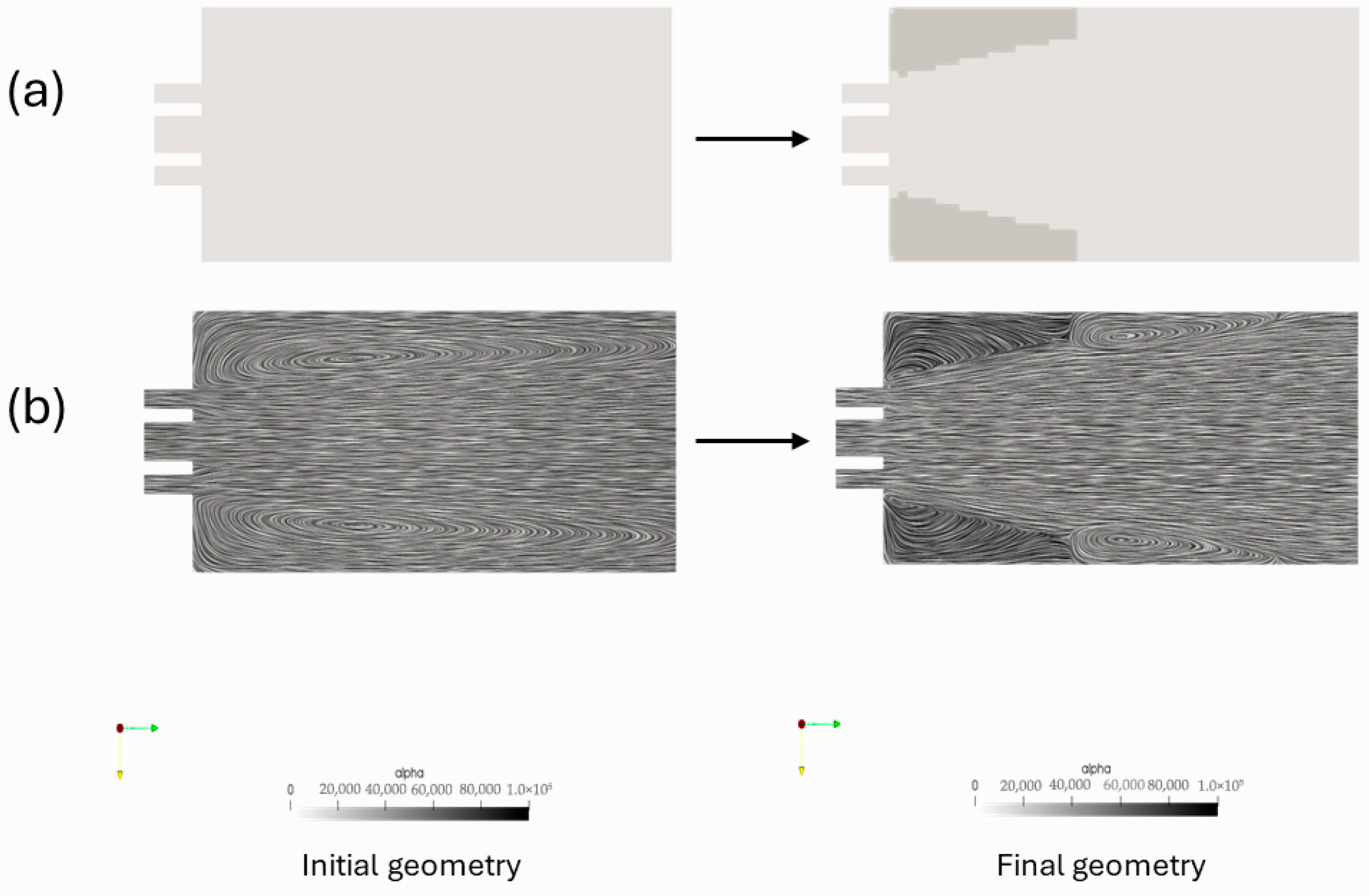
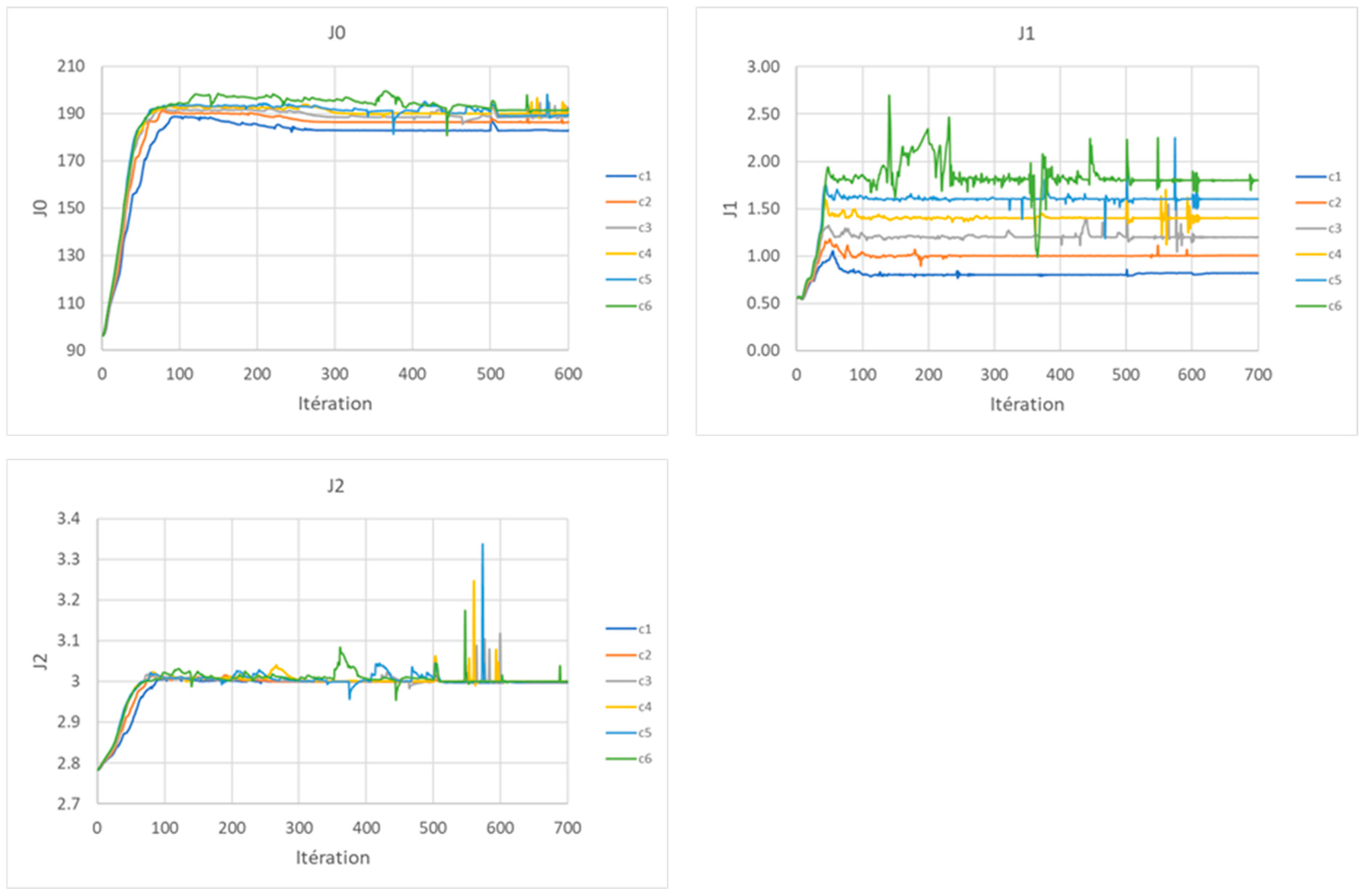
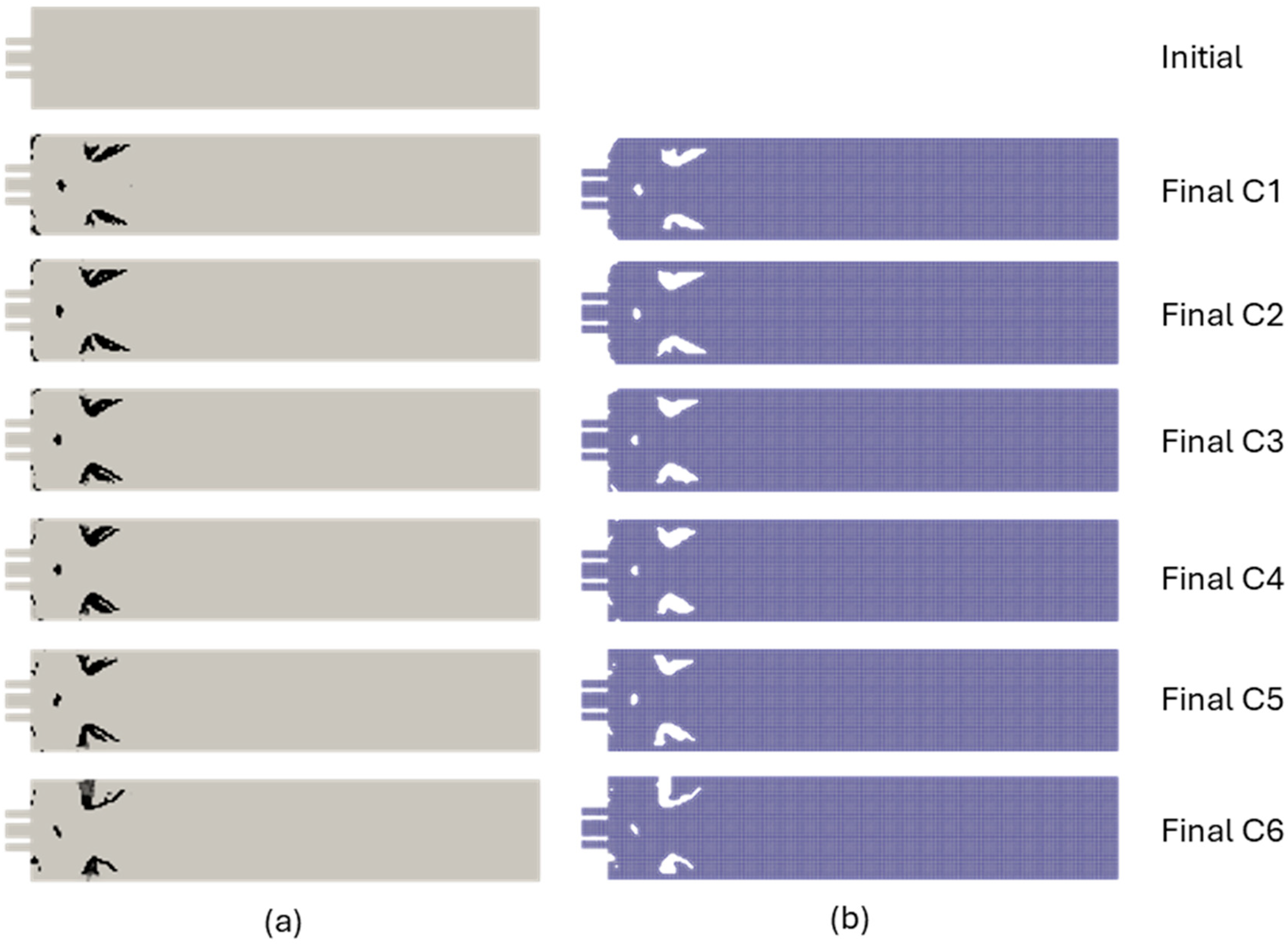
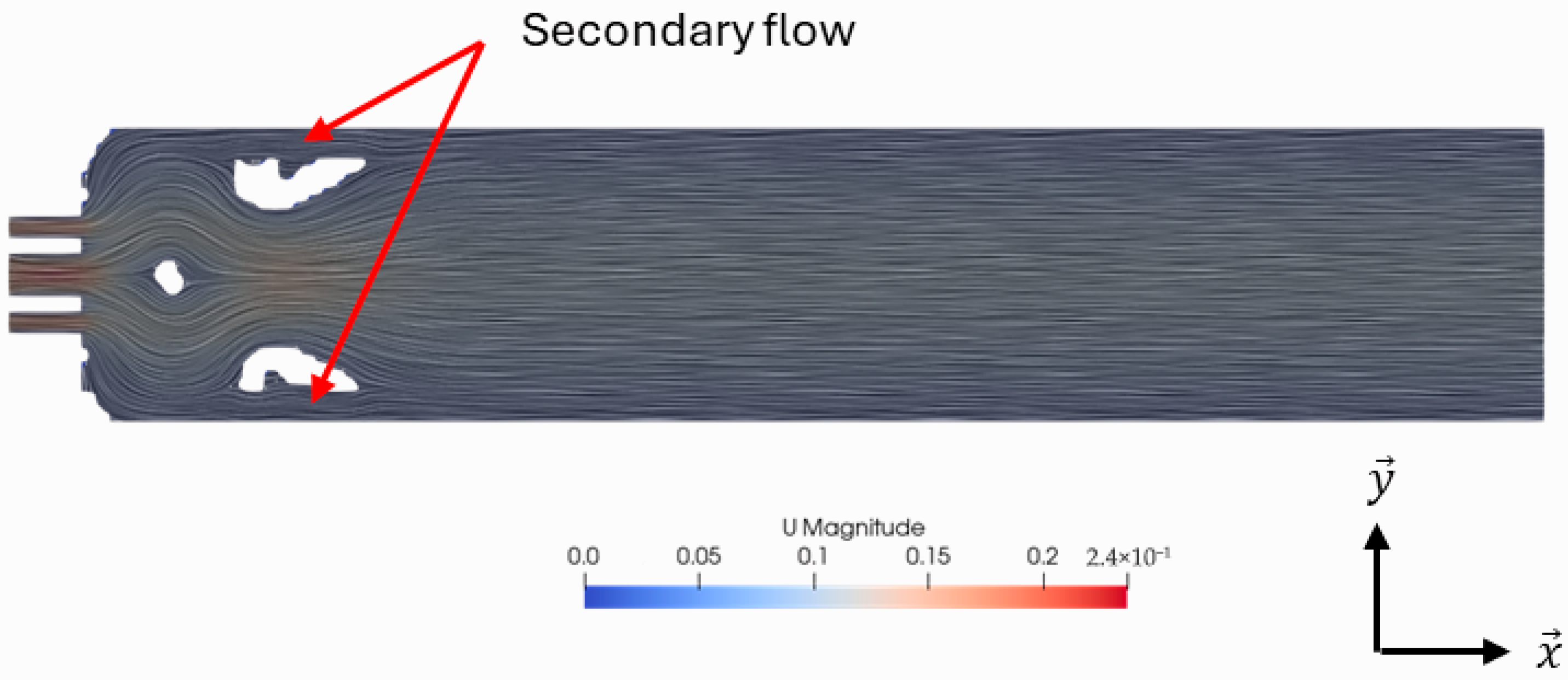
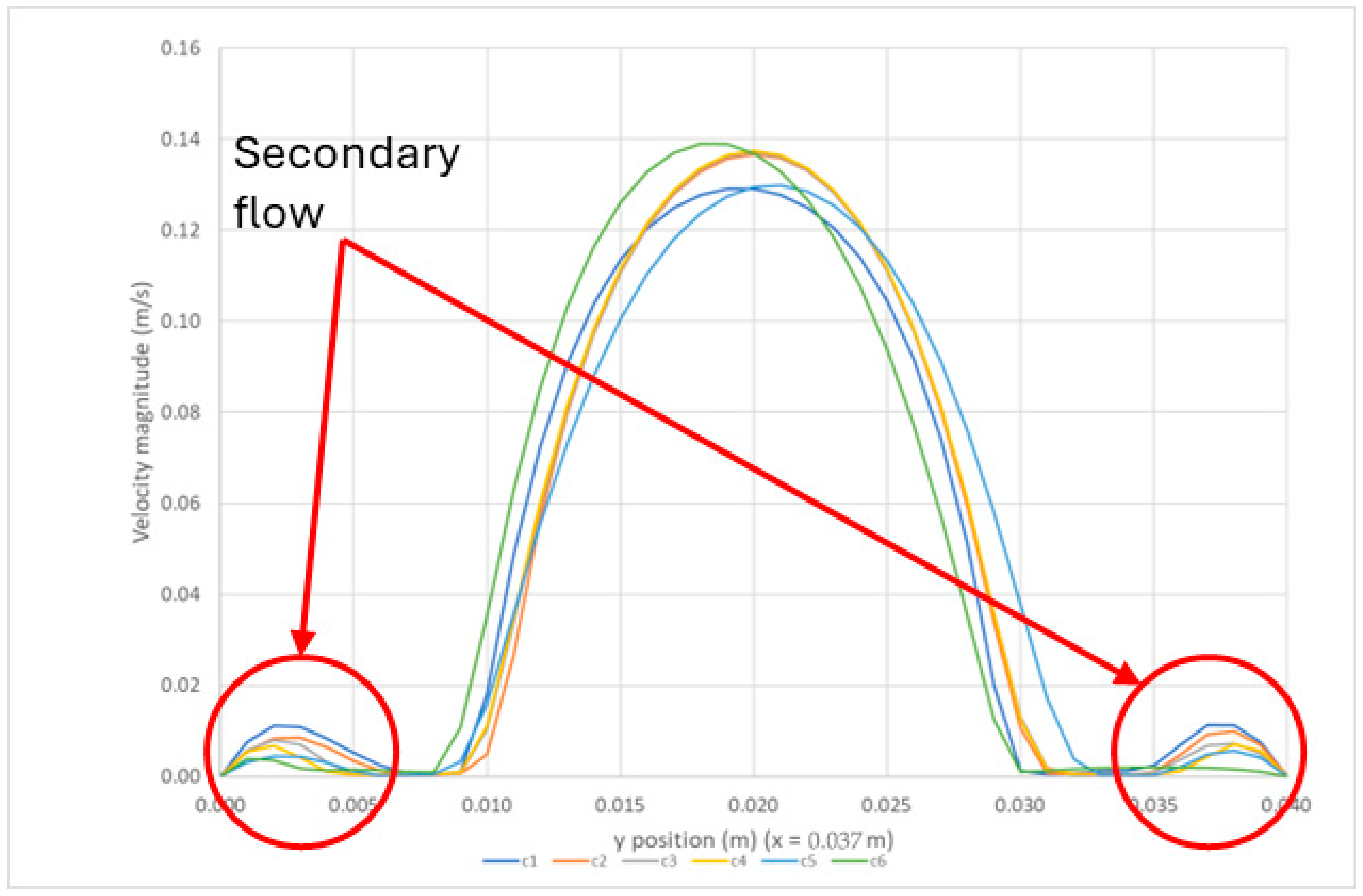
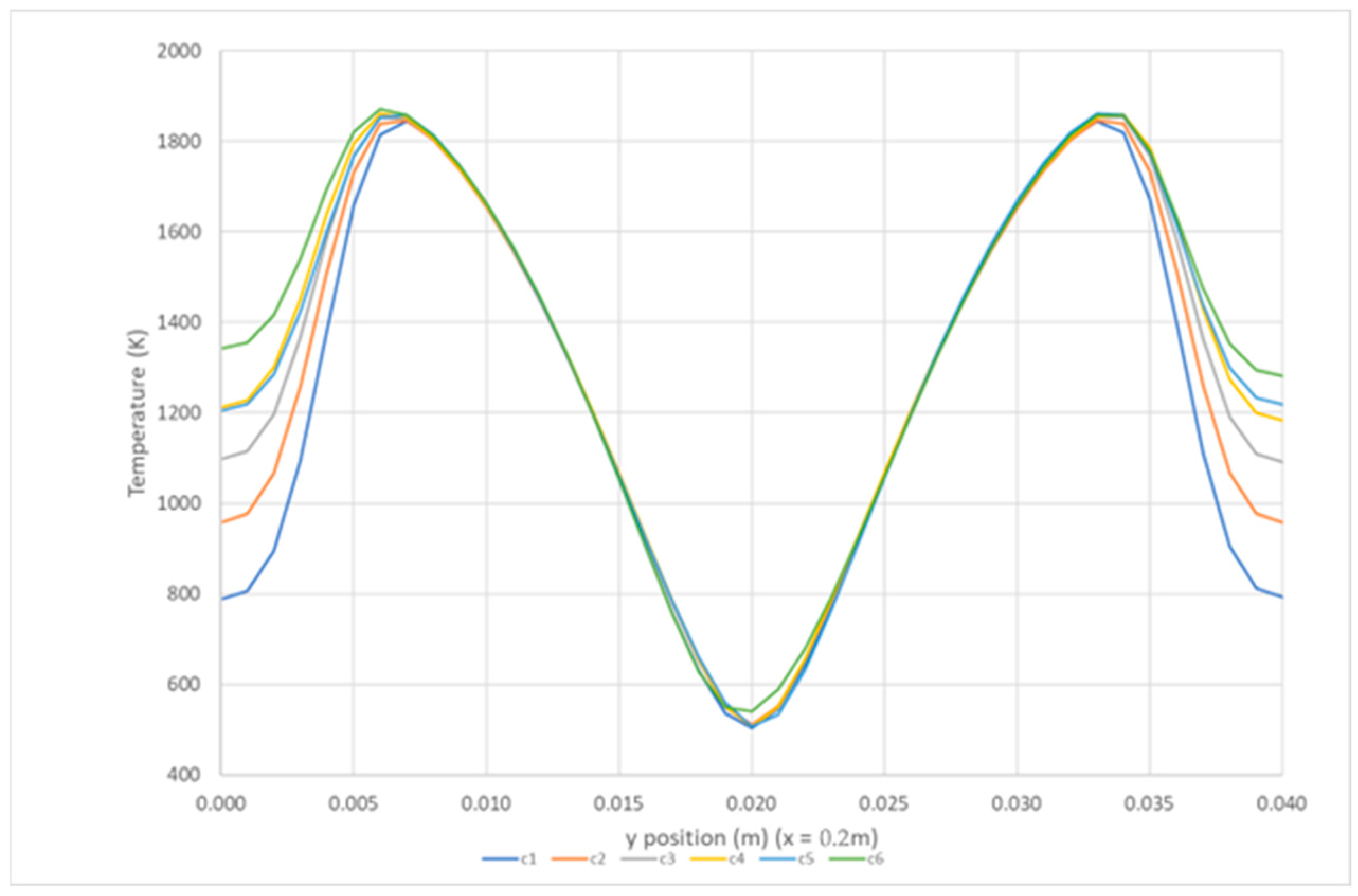

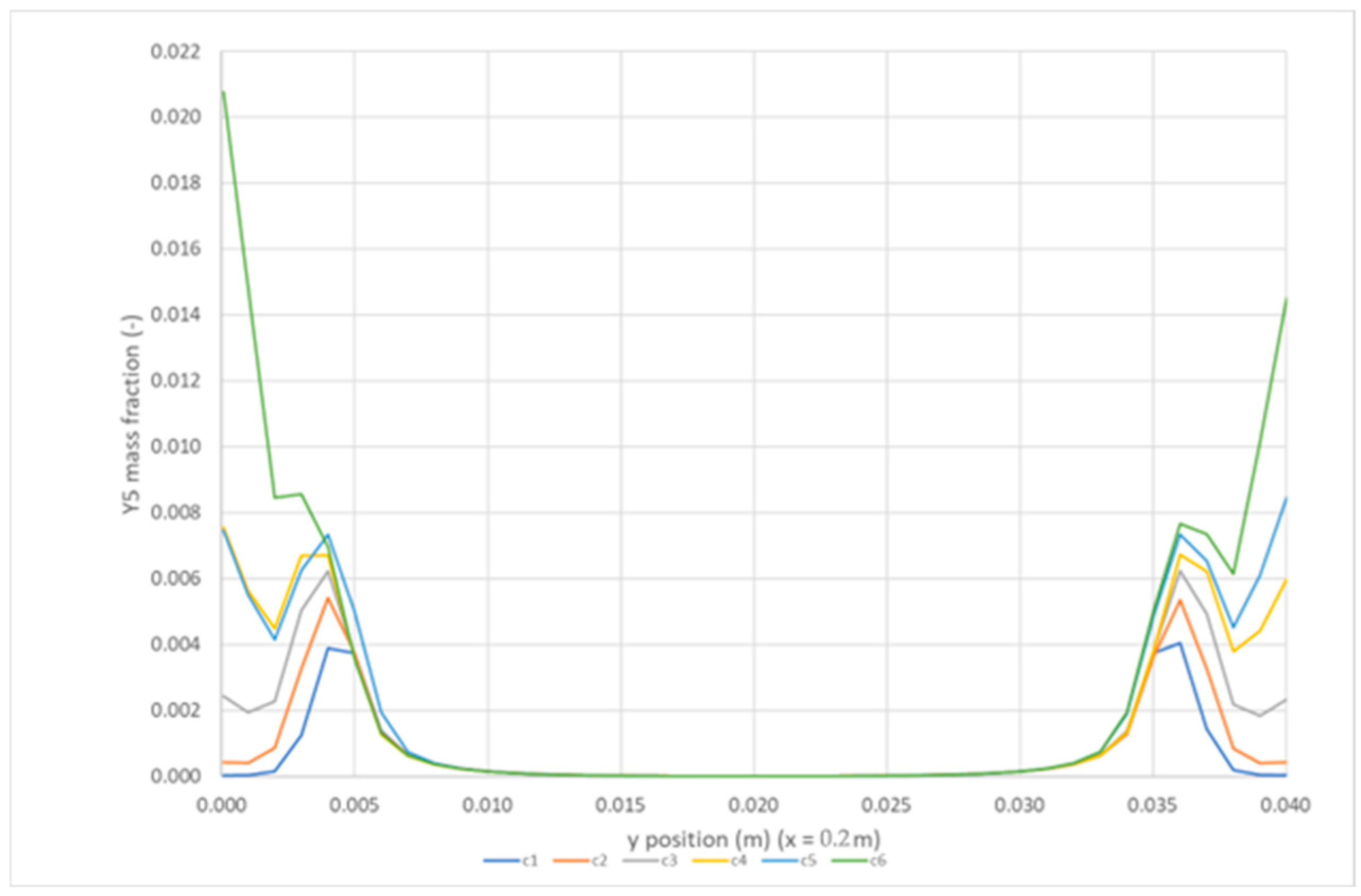
| mm | 6 | |
| mm | 10 | |
| mm | 16 | |
| mm | 20 | |
| mm | 10 | |
| mm | 200 | |
| mm | 50 |
| Pa | m/s | - | - | - | - | - | K | |
| Inlet 1 | 300 | |||||||
| Inlet 2 | 300 | |||||||
| Outlet | ||||||||
| Walls |
| ID | C1 | C2 | C3 | C4 | C5 | C6 |
|---|---|---|---|---|---|---|
| 0.8 | 1 | 1.2 | 1.4 | 1.6 | 1.8 | |
| 3 | 3 | 3 | 3 | 3 | 3 |
| C1 | C2 | C3 | C4 | C5 | C5 | |
|---|---|---|---|---|---|---|
| Initial geometry | 96.0 | 96.0 | 96.0 | 96.0 | 96.0 | 96.0 |
| Final geometry | 182.8 | 186.2 | 188.3 | 189.7 | 189.1 | 190.8 |
| Gain | 90.4 | 93.9 | 96.1 | 97.6 | 96.9 | 98.7 |
| C1 | C2 | C3 | C4 | C5 | C5 | |
|---|---|---|---|---|---|---|
| Initial geometry | 96.0 | 96.0 | 96.0 | 96.0 | 96.0 | 96.0 |
| Final geometry | 186.8 | 189.9 | 189.8 | 191.4 | 193.7 | 197.0 |
| Gain | 94.6 | 97.8 | 97.7 | 99.3 | 101.7 | 105.2 |
Disclaimer/Publisher’s Note: The statements, opinions and data contained in all publications are solely those of the individual author(s) and contributor(s) and not of MDPI and/or the editor(s). MDPI and/or the editor(s) disclaim responsibility for any injury to people or property resulting from any ideas, methods, instructions or products referred to in the content. |
© 2025 by the authors. Licensee MDPI, Basel, Switzerland. This article is an open access article distributed under the terms and conditions of the Creative Commons Attribution (CC BY) license (https://creativecommons.org/licenses/by/4.0/).
Share and Cite
Pancin, H.; Le Moyne, L.; Jouanguy, J.; Sophy, N. Contribution to the Topological Optimization of Reactive Flows. Designs 2025, 9, 95. https://doi.org/10.3390/designs9040095
Pancin H, Le Moyne L, Jouanguy J, Sophy N. Contribution to the Topological Optimization of Reactive Flows. Designs. 2025; 9(4):95. https://doi.org/10.3390/designs9040095
Chicago/Turabian StylePancin, Hugo, Luis Le Moyne, Julien Jouanguy, and Nadjiba Sophy. 2025. "Contribution to the Topological Optimization of Reactive Flows" Designs 9, no. 4: 95. https://doi.org/10.3390/designs9040095
APA StylePancin, H., Le Moyne, L., Jouanguy, J., & Sophy, N. (2025). Contribution to the Topological Optimization of Reactive Flows. Designs, 9(4), 95. https://doi.org/10.3390/designs9040095







